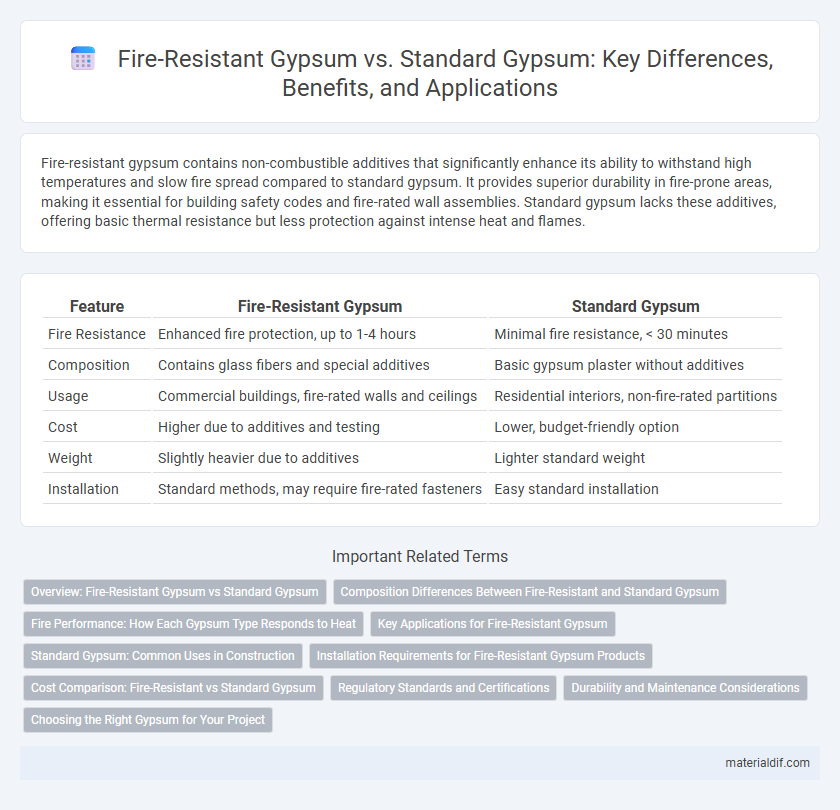Fire-resistant gypsum contains non-combustible additives that significantly enhance its ability to withstand high temperatures and slow fire spread compared to standard gypsum. It provides superior durability in fire-prone areas, making it essential for building safety codes and fire-rated wall assemblies. Standard gypsum lacks these additives, offering basic thermal resistance but less protection against intense heat and flames.
Table of Comparison
| Feature | Fire-Resistant Gypsum | Standard Gypsum |
|---|---|---|
| Fire Resistance | Enhanced fire protection, up to 1-4 hours | Minimal fire resistance, < 30 minutes |
| Composition | Contains glass fibers and special additives | Basic gypsum plaster without additives |
| Usage | Commercial buildings, fire-rated walls and ceilings | Residential interiors, non-fire-rated partitions |
| Cost | Higher due to additives and testing | Lower, budget-friendly option |
| Weight | Slightly heavier due to additives | Lighter standard weight |
| Installation | Standard methods, may require fire-rated fasteners | Easy standard installation |
Overview: Fire-Resistant Gypsum vs Standard Gypsum
Fire-resistant gypsum contains special additives like glass fibers and non-combustible materials that enhance its ability to withstand high temperatures and prevent fire spread. Standard gypsum, primarily composed of calcium sulfate dihydrate, offers basic fire resistance due to its moisture content but lacks the reinforced properties found in fire-resistant variants. This makes fire-resistant gypsum a preferred choice in construction projects requiring higher safety standards and compliance with fire codes.
Composition Differences Between Fire-Resistant and Standard Gypsum
Fire-resistant gypsum contains additives such as glass fibers, vermiculite, and special chemicals that enhance its thermal resistance, unlike standard gypsum which primarily consists of calcium sulfate dihydrate without these reinforcements. The inclusion of these fire-retardant materials in fire-resistant gypsum improves its ability to withstand higher temperatures and delay the spread of flames. Standard gypsum's simpler composition makes it less effective in maintaining structural integrity during fire exposure.
Fire Performance: How Each Gypsum Type Responds to Heat
Fire-resistant gypsum contains additives like glass fibers and special binders that enhance its ability to withstand high temperatures, providing superior fire protection compared to standard gypsum. Standard gypsum typically includes regular calcium sulfate dihydrate, which offers basic heat resistance but deteriorates faster under intense fire conditions. As a result, fire-resistant gypsum is preferred in construction for improved structural integrity and safety during fire exposure.
Key Applications for Fire-Resistant Gypsum
Fire-resistant gypsum is engineered with additives like glass fibers and enhanced gypsum core to provide superior fire protection compared to standard gypsum, making it ideal for use in commercial buildings, hospitals, and schools where fire safety regulations are stringent. Its key applications include fire-rated wall assemblies, ceiling systems, and shaft wall partitions that require extended fire resistance ratings from 1 to 4 hours according to ASTM E119 standards. These specialized boards help contain fire, reduce smoke spread, and maintain structural integrity, ensuring occupant safety and compliance with building codes.
Standard Gypsum: Common Uses in Construction
Standard gypsum is widely used in construction for interior wall and ceiling applications due to its affordability and ease of installation. It provides good sound insulation and smooth finishes suitable for residential and commercial buildings. Unlike fire-resistant gypsum, it lacks additives that enhance fire protection, making it less suitable for areas with stringent fire safety requirements.
Installation Requirements for Fire-Resistant Gypsum Products
Fire-resistant gypsum products require specific installation methods, such as using moisture-resistant joint compounds and fire-rated screws, to maintain their integrity under high temperatures. These products often need to be installed with precise spacing and sealed with fire-resistant materials to prevent heat and smoke penetration. Compliance with building codes like ASTM E119 and UL 263 is crucial for ensuring the fire-resistant gypsum assemblies perform effectively in fire scenarios.
Cost Comparison: Fire-Resistant vs Standard Gypsum
Fire-resistant gypsum typically costs 20-30% more than standard gypsum due to its enhanced chemicals and additives that improve fire resistance. Standard gypsum remains popular for budget-sensitive projects, offering sufficient durability at a lower price point. The higher initial investment in fire-resistant gypsum can reduce long-term insurance costs and increase building safety compliance.
Regulatory Standards and Certifications
Fire-resistant gypsum typically complies with rigorous regulatory standards such as ASTM C1396 and UL 263, ensuring enhanced fire protection for building applications. Standard gypsum meets basic codes but lacks the fire-resistant additives that qualify it for certifications like NFPA 101 and UL fire ratings. Choosing fire-resistant gypsum aligns with international fire safety regulations, providing verifiable performance for occupant safety and building code compliance.
Durability and Maintenance Considerations
Fire-resistant gypsum contains additives like glass fibers and non-combustible materials that enhance its durability under high-heat conditions compared to standard gypsum. This specialized composition reduces cracking, warping, and degradation, resulting in lower maintenance requirements over time. Standard gypsum, while cost-effective, typically demands more frequent repairs when exposed to fire or moisture, impacting long-term durability and upkeep.
Choosing the Right Gypsum for Your Project
Fire-resistant gypsum contains glass fibers and special additives that enhance its ability to withstand high temperatures and prevent flame penetration, making it ideal for applications requiring increased fire protection. Standard gypsum, while cost-effective and easy to install, offers limited fire resistance and is best suited for non-critical areas where fire safety regulations are less stringent. Selecting the right gypsum board depends on project-specific fire safety requirements, building codes, and budget constraints to ensure optimal performance and compliance.
Fire-resistant gypsum vs Standard gypsum Infographic

 materialdif.com
materialdif.com